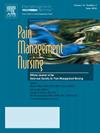埃塞俄比亚的分娩疼痛管理:系统回顾与元分析》。
IF 2.1
4区 医学
Q2 NURSING
引用次数: 0
摘要
目的:分娩疼痛是一种主观现象,因产妇的期望而异。为了获得积极的分娩体验,产妇应根据自己的要求减轻疼痛。因此,本研究旨在确定埃塞俄比亚产科护理人员对分娩镇痛的使用情况及相关因素:搜索了不同的电子数据库(即 PubMed、Scopus、Embase、CINAHL、DOAJ、Web of Science、MEDLINE、Cochrane Library、ScienceDirect 和 CAB Abstracts)以获取已发表的研究,而 Google Scholar 和 Google Search 则用于获取未发表的研究:综述/分析方法:全程采用《系统综述和元分析首选报告项目》指南。使用 EndNote X8 删除重复结果。质量由 JBI 工具评估。使用 Stata 17 进行分析。采用随机效应模型,并以森林图展示结果。使用Cochran's Q检验和I2检验评估异质性和发表偏倚:药物止痛的总利用率为 28%(95% CI [12,43]),而非药物止痛的总利用率为 43%(95% CI [37,49])。产科护理人员的态度与药物和非药物分娩镇痛均呈正相关(调整后的几率比=1.73,95% CI [1.20,2.26];调整后的几率比=2.94,95% CI [2.01,3.87]):埃塞俄比亚产科医护人员对分娩镇痛的利用率很低。医疗服务提供者的态度与分娩镇痛管理呈正相关。建议对产科医护人员进行现场培训,以改善分娩镇痛的实践。©20XX年美国疼痛管理护理学会。本文章由计算机程序翻译,如有差异,请以英文原文为准。
Labor Pain Management in Ethiopia: A Systematic Review and Meta-Analysis
Objectives
Labor pain is a subjective phenomenon that varies based on women's expectations. To have a positive childbirth experience, laboring women should have pain relief based on their request. Therefore, this study aimed to determine the utilization of labor pain management and associated factors among obstetric caregivers in Ethiopia
Data Sources
Different electronic databases (i.e., PubMed, Scopus, Embase, CINAHL, DOAJ, Web of Science, MEDLINE, Cochrane Library, ScienceDirect, and CAB Abstracts) were searched for published studies, whereas Google Scholar and Google Search were used for unpublished studies.
Review/Analysis Methods
Preferred Reporting Items for Systematic Reviews and Meta-Analyses guidelines were used throughout this work. Duplicate results were removed using EndNote X8. Quality was assessed by the JBI tool. Stata 17 was used for analysis. A random effects model was used, and the results were presented using a forest plot. Heterogeneity and publication bias were evaluated using Cochran's Q test and I2 test.
Results
The pooled utilization of pharmacological pain management was 28% (95% CI [12, 43]), whereas the pooled estimate of nonpharmacological pain management was 43% (95% CI [37, 49]). Obstetric care provider attitude was positively associated with both pharmacological and nonpharmacological labor pain management (adjusted odds ratio = 1.73, 95% CI [1.20, 2.26], adjusted odds ratio = 2.94, 95% CI [2.01, 3.87], respectively).
Conclusions
Labor pain management utilization among obstetric care providers in Ethiopia was poor. Health care provider attitude was positively associated with labor pain management. On-site training was recommended for obstetric care providers to improve the practice of labor pain management.
© 20XX by the American Society for Pain Management Nursing
求助全文
通过发布文献求助,成功后即可免费获取论文全文。
去求助
来源期刊

Pain Management Nursing
医学-护理
CiteScore
3.00
自引率
5.90%
发文量
187
审稿时长
>12 weeks
期刊介绍:
This peer-reviewed journal offers a unique focus on the realm of pain management as it applies to nursing. Original and review articles from experts in the field offer key insights in the areas of clinical practice, advocacy, education, administration, and research. Additional features include practice guidelines and pharmacology updates.
 求助内容:
求助内容: 应助结果提醒方式:
应助结果提醒方式:


